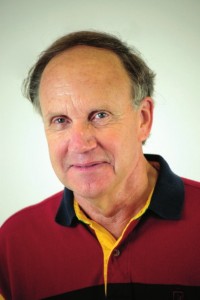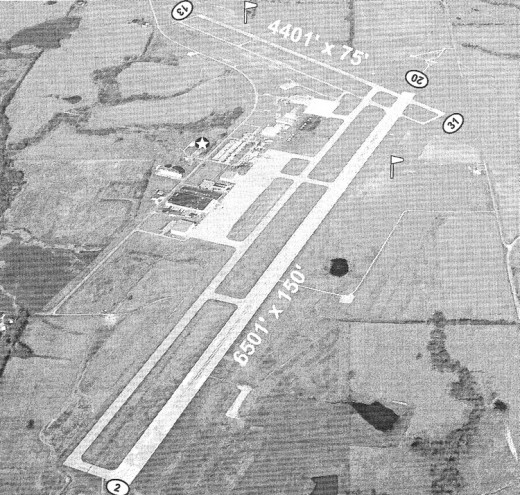It’s time to ramp up airport development | From the Roundtable
by Al Germond
May 13, 2011

Although still anonymous, we’ll ultimately discover the entity in question and where it chose to settle. As we lick our wounds, it’s time to move on and improve our region’s air transportation interface with the world via Columbia Regional Airport.
I believe Columbia was originally lulled into complacency relative to airline transportation by its proximity to the St. Louis Airport, Lambert International, 110 miles away or less than two hours east of here via Interstate 70. Assumptions were made that TWA — Trans World Airlines — would be at Lambert forever operating a hub with a wide variety of connections including various nonstop international flights.
Remember when Lambert was something like the ninth-busiest airport in North America? Now TWA is gone, outmaneuvered by a string of financial manipulators, and much of Lambert is sitting unoccupied. The St. Louis facility is only passively supported by one of TWA’s original rivals, American Airlines, based in Dallas.
The die was cast beginning in the late 1930s, coincident with the city’s development of the old municipal airport, which opened in 1938 where Cosmo Park sits today.
A consolidation of several carriers and a carrier with many firsts, TWA occasionally prospered but mostly struggled during the years Howard Hughes owned 79 percent of the company. His eccentricities crippled the carrier for years until 1961 when a new directorate was installed, armed with the financial means to tardily fill out TWA’s fleet of planes with brand-new jets, including a fleet of Convair 880s.
Any hope now for reviving Lambert to its former glory is very dim indeed. Still, we wonder if having an airport with international connections two hours away would be acceptable to any of the potential suitors our reinvigorated industrial development folks have been visiting with. Do the required air connections really have to be in our backyard?
With Lambert a shell of its former glory, the region has been wisely concentrating on Columbia Regional Airport. Grateful to Delta Airlines for its three flights a day to Memphis filled almost to capacity, our scheduled passenger aviation development plows ahead on two fronts, which grabs additional service and improves the airport itself. The two are intertwined and closely related.
First, the facility
Aviation consultant Hare and Hare came up with a pool of more than 20 potential sites for the new airport in 1963. The Federal Aviation Administration insisted on funding only a single regional facility serving Columbia, Jefferson City and other mid-Missouri communities.
The present Elkhurst site was chosen because it met the FAA’s criteria. Pilots have found it satisfactory, aside from its relative proximity to the 774-foot-high KOMU TV tower, which imposes some restrictions on flights to and from the north. The main 2-20 runway (a shorthand designation related to its bearings with respect to true north) is 6,500 feet long, and the 13-31 crosswind runway is 4,400 feet long. Funding has been secured to add 500 feet to the main runway. But the crosswind runway must be lengthened and improved before the main runway is rebuilt and extended.
I’ve long felt that Columbia Regional Airport was a major burden to the majority of our city councilors and the city staff, borne with reluctance and backed more fervently by ardent users and aviation enthusiasts.
The decision almost half a century ago to lay down a main runway only 6,500 feet long has, I believe, left us with something barely adequate. Twenty or 30 years ago, using federal funds more readily available, construction of a longer runway — on the order of 8,000 feet on a more substantial base — would not have us scratching around for the puny 500-foot extension the city will soon embark on building. The Springfield-Branson National Airport has two runways 7,000 and 8,000 feet long; why weren’t we lengthening our runways years ago when it would have been easier to do?

No one could have anticipated 9/11 and the subsequent stringencies applied to civil aviation that occasionally turn air travel into a nightmare. But now we have to deal with the terminal itself. It’s equipped, under present Transportation Security Administration guidelines, to handle only one flight at a time. Scheduling additional flights around Delta’s existing three flights per day would be difficult without expansion. But that’s a problem we look forward to dealing with.
That leads us to our second realm of considerations: expanding scheduled airline service out of Columbia Regional Airport.
Here are several points worth considering:
1. Let’s determine both present and prospective use of CRA by residents of the two central Missouri metropolitan statistical areas (Boone, Howard, Cole, Linn, Callaway and Linn counties), Audrain, Randolph and Cooper counties, the Lake of the Ozarks area and perhaps others. Then let’s get more specific, assessing use by the University of Missouri, state government and every employer in the region. Determine destinations, frequency of service and international transportation requirements and connections.
2. This should lead to establishing a regional air transportation authority with the active participation by the aforementioned counties to eventually operate and support CRA. They would subsidize expanded air service with guaranteed payments to a prospective second or additional carrier as they establish new services. Following models found in other jurisdictions, the CRA Authority would be authorized to float tax-free bonds to fund expansion such as the sorely needed TSA-compliant terminal facility.
3. The University of Missouri is the elephant in this concourse of commercial aviation requirements, yet I understand MU has no centralized, coordinated air transportation office. One scandal years ago uncovered that when MU staffers wished to fly somewhere, they would book the flight themselves using an out-of-town airport. That practice allowed them to be paid generously by the mile for driving and parking there. We need some numbers here: flight requirements per week by faculty and staff with destinations. Here’s a little fillip: Imagine the accumulation of frequent flyer miles that would accrue to the university and the money the institution would save.
4. Beginning with Columbia, let’s determine the present and prospective flying requirements of its other employers both large and small. Then assess the casual, recreational and personal travel needs both in quantity and destination. Where do the folks want to go? Aside from the historic interest in direct flights to the Chicago-O’Hare and Dallas-Fort Worth airport megaplexes, murmurings are now being heard about service to Detroit, Minneapolis-St. Paul and Denver.
Maybe we’ll have to step up and subsidize additional service, but first let’s get a handle on the market for service in and out of CRA and go from there. If subsidies are in our future, let’s figure out how to arrange them. Smart people are looking at the situation as it exists today, but now’s the time to ramp things up and get even smarter about Columbia Regional Airport and what we want it to become.


